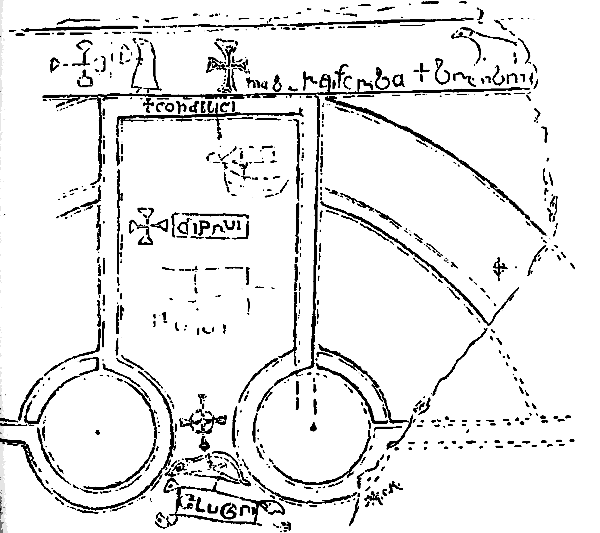
[From Proc IoMNHAS vol 1]
By MR. P. M. C. KERMODE.
In examining the ruins of an old Keeill on Ballavarkish, not far from the Parish Church of Kirk Bride, we came across a slab bearing the remains of an early cross. The stone may have come from the hills near Sulby, about six miles to the south-west, and to have brought it across the curragh at the period when it was carved, must have been a tedious and difficult task.

It now measures 23 inches by 20, and 1½ in. thick and is evidently flaked off a flag probably 3 in. or more in thickness, the full width of which must have been about 26½ in., while its length may have been five feet. The surface is carefully dressed, and shows incised in outline, within a rectangular panel, a cross of Celtic form with limbs connected by a true circle ; the recesses between the limbs are also circular ; the side limbs are unusually long in comparison with the head. The lines, V-shaped in section, are smoothly chiselled a quarter of an inch wide and about the same deep ; the centres of all the circles are marked by drilled holes ; the cross and inner margin of the connecting ring are bordered by lines which in the latter are extremely fine.
Across the centre and upper limb are the inscriptions in Latin, with another on the upper bar of the surrounding rectangular frame; there are figures of crosslets and of animals and some fine lines which, if they have any meaning, represent unfinished designs.
About the centre is a name carefully chiselled and contained within a snall rectangular panel, the corners of which are decorated with birds' heads. A flourish, which at a first glance might be taken for a letter, is followed by the word LUGR I. In the middle of the upper limb, another name is chiselled within a rectangular panel, preceeded by a small cross, but the panel is not ornamented ; this reads--DIPRUI. The upper border of the same limb contains a third name, with cross, cut lightly, not with a chisel, namely-CONDLICCI. There is yet another inscription on the upper bar of the surrounding panel ; this is scratched rather than cut, and some of the letters are flaked or worn away, but it appears to read-MAB[O]R[Al]SCRIBA+BRERB . . . It looks as if there had been another word scratched very lightly below the name on the upper limb ; the initial is distinctly the small Celtic R, and is followed by still fainter marks, which may be UUI.
The figure of an animal just above the first name may possibly, from its position on the Cross, and from the fact that there is a decorated crosslet cut above it, be intended for a representation of the Agnus Dei ; if so, it is the first instance yet found on our Manx monuments. The other figures would seem to be purely decorative, suggesting the little drawings scribbled on the margins of Celtic MSS. The little robed and hooded figure in the upper border seems to be carrying a harp, shalm or psaltery.
In the first two names the letters consist of capitals and minus-cules mixed ; in the others they are in minuscule. Their character indicates the period as that of the seventh or early eighth century, and this is interesting as an indication of the date when the Celtic form of cross came into use in the Isle of Man. A fragment from Maughold, " Manx Crosses," No. 23, uninscribed, shows a similar form, also within a rectangular panel.
All the names appear to be Latinised forms of Celtic men's names, though previously unknown. The one near the centre, in the decorated panel, would be that of the man, possibly a cleric, to whom the monument was first erected ; that on the upper limb, also contained within a panel, and showing a resemblance in the lettering, would be the next. Then probably the name on the border of the same limb, more lightly cnt. One reason why so many should have been commemorated on the same tombstone might be that they belonged to the same monastic " family"-were clerics connected with the same Keeill Varkish, or St. Mark's Church. The inscription on the top, which is entirely in minuscule. gives the name of the man who cut the little figures on the cross and, perhaps, the third name. 'these figures, and the forms of the small letters with their flourishes, suggest the hand of a penman rather than that of a sculptor, and this is explained by the word SCRIBA. From the beginning of the sixth century, the Scribe was a very important personage in a Celtic monastery. In the " Annals of the Four Masters' we meet with many of their names, but, in the Isle of Man where we have no such annals or early records, this is the first contemporary evidence of their existence.
On the left edge of the stone are three carefully chiselled scores, which have all the appearance of being the remains of an Ogam inscription. We searched in and around the foundations of the Keeill for any further remains of the slab, but found no trace of it or of any other. I am happy to say that Mrs E. Farrant has presented the stone to the Museum Trustees who propose to have it set up along with others from the parish in the shelter erected at Bride Church
|
|
||
|
Any comments, errors or omissions
gratefully received MNB
Editor |
||